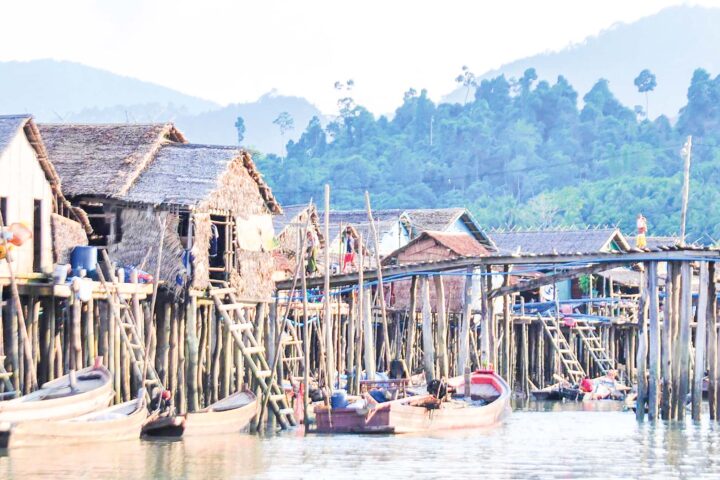Myanmar is strategically located with its strategic coastlines, rich natural resources and biodiversity, hills and valleys, mountain ranges and lowlands. Furthermore, Salon people also known as Moken are living in the Myeik Archipelago and Kawthoung islands in the southern part of Myanmar. Salon people are one of the smallest indigenous groups of Myanmar and recognized ethnic groups among the country’s 135 distinct ethnic groups. Their population is estimated at about 2,000. They maintain nomadic sea culture and hunter-gatherer lifestyle, traditionally living on the wooden boat called Kabang.
Tourism based on Salon people to become a popular destination in the region
Salons or Moken people roam freely around the islands and they were noticed before 1962. In 1980, 56 households from Pearl Island where Salon people lived were removed and some were migrated to the islands in Thailand. Over 800 islands in the Myeik Archipelago, Taninthayi Region, 12 islands in Kawthoung and Myeik districts are home to Salons. They have their own language, culture and traditions. They roam in the sea in times of pleasant weather conditions. They hunt the wild and stay at the islands for a while in extreme weather conditions. With the climate change, degradation of marine resources and loss of access to land and territory, the islands where Salons inhibit has become smaller. As they belong to the unique living styles, the population growth declined. This small group is required to protect from extinction. The traditions and rituals of Salon people pass from generation to generation, attracting tourists and local travellers. The tour destination based on Salon people combined with the ecotourism can enhance the livelihoods of the Salons in a short time. Moreover, it can generate foreign currency from tourism. It is hoped to become a popular destination in the region.
Protecting indigenous communities
They lead a nomadic life and survive on what they can forage in the sea. According to the 2019 census, only 1,700 survived. As they roam in the sea, they are prone to malaria and malnutrition. At present, the Salon population increased to 2,000. It is vital of importance to protect the indigenous people and endangered cultures from extinction as a national duty for the generations.
One of the smallest indigenous races
Moken’s origins are known to be from Malaysia’s islands and moved to the Myeik Archipelago due to attacks. They built stilt houses in the Heinze, Boke, Maungmakan, Shinmon, Mali, Pyingyi, Kadan, Don, Wah, Lampi, Meesin and other islands to keep themselves safe in the adverse weather conditions. They usually roam between the islands, reefs and coasts by wooden boat. Salons are the invaluable cultural heritage of the nation. There was a ritual to get familiar with water that they submerged the newborn baby into the water afterbirth three times as of 1964. Some of the babies died after submerging, prompting this traditional belief. The Moken people can hold their breath underwater and free dive deeper than any other human being on earth. The kids are said to swim first before they start learning how to walk. They showed no sign of greed or materialism. They are well known as sea gipsies due to their nomadic sea culture. They inhibit in the Myeik Archipelago as the indigenous race called Salon or Moken.
People endowed natural gifts
Salon people eat seafood. The cockles and mussels clinging to rocks are harvested and sold at the market during their stay at island. As they’re famous cuisine at hotels, fishers other than Salons have increasingly harvested cockles. As a result of this, they have become rare.
The innards of cockles are taken out, boiled, and dried. They can be used in soup, fried and preserved recipes. They fetch up to K100,000 per viss (a viss equals 1.6 kilogrammes). Consequently, many fishers eye that business. As they usually cook healthy food with minimum oil, they are free from hypertension. The native plants including watercress can be found on islands. Salons can catch aquatic animals with sustainable and traditional fishing practices with minimal impact on the environment. They can collect beehives and edible bird nests in the caves without any equipment. They are a nomadic seafaring tribe with natural gifts that lack the accumulation of materials.
Sincere and peace-loving native, preserving culture required
They hunt and gather seafood such as cockles, mussels, scallops, squid, seashells and seaweed edible bird nests, honey and herbal plants. They do coastal foraging for living and they’re not interested in agriculture and livestock businesses. They separately dwell in the islands and near Myeik city. They were far from urban and modern living styles. They previously wear only one sarongs in the past generation. Nevertheless, some adapt to life on land, wear full clothing, use motorboats instead of traditional wooden boats and catch fish with harmful fishing practices. It harms the image of the tradition and customs of the Salon people. Although their changing lifestyle such as living in houses with corrugated iron sheets instead of stilt house is comfortable for them, it is crucial to maintain their tradition and customs which can influence the tourist attraction.
Strong spiritual beliefs from generation to generation
Salons hold spiritual beliefs. They have been worshipping the Nats (spirits) until now. The shaman is a very important person for them. They receive treatments from clinics and hospitals, by adapting to changing ages. Yet, they still practice what the shaman directs during illness, death, festival, wedding and any events. They yearly hold Nat worshipping events, offering corn, rice, honey, alcohol, chicken, sea tortoise, goat and duck blood to Nats according to the shaman. They enjoy festivals and weddings with the campfire, folk dance and songs. A traditional boat called Kabang is made of wood. Drums are made of the skin of chameleon and iguana. They are used as musical instruments at the festival. Additionally, they mark ancestor worship every year. They treat the food to the ghosts at the cemetery after spiritual worshipping with the shaman. They all dance along with the shaman and the practitioners confessed their sufferings to the deceased ones and asked them to prevent misfortune and protect them. Burials take place after death rather than cremation according to their beliefs. They buried the belongings of the dead together with the deceased one’s remains. They follow the shamans’ guidance until now.
Salon people’s culture and living styles captivate the tourists
The country’s cultural heritage is one of the main elements of tourism. Myanmar has more than a hundred ethnic groups with diversity in culture. Its unique and appealing customs and traditional beliefs and cultural heritage draw the attention of the tourists. The culture-based tourism explores its own culture and learns how to preserve its heritage. Myanmar’s ethnic people proudly stand with their respective own cultures. Tourists eye Myanmar for its untouched islands, fertile lands, long coastline, hill regions and natural resources. Myanmar is also a popular destination for tourists among regional countries. The living styles, their traditional beliefs and culture that are passed down from generation to generation are enchanting tourists. The blue sea and islands off the coast in southern Myanmar are home to Moken or Salon people.














